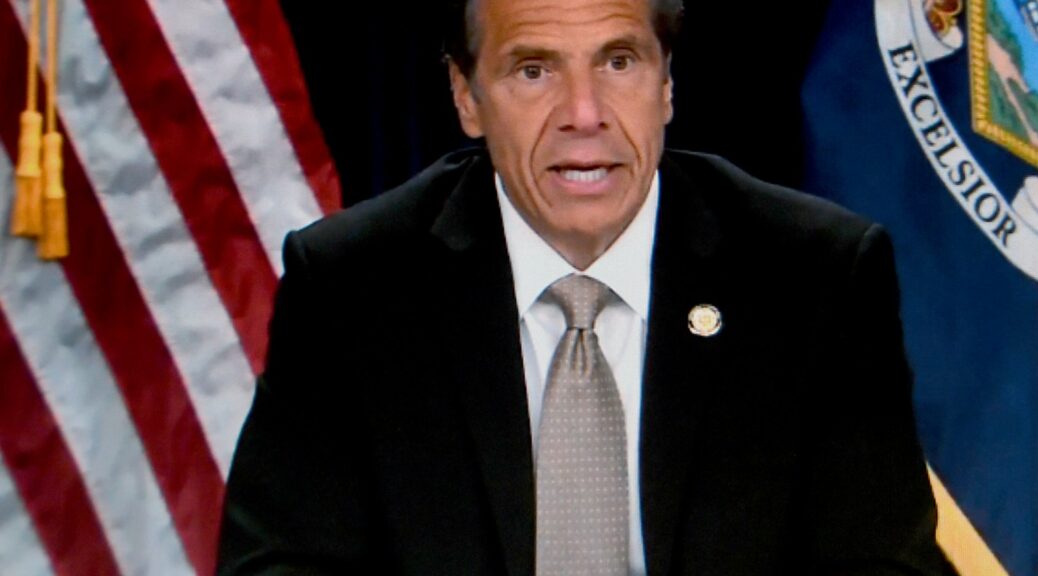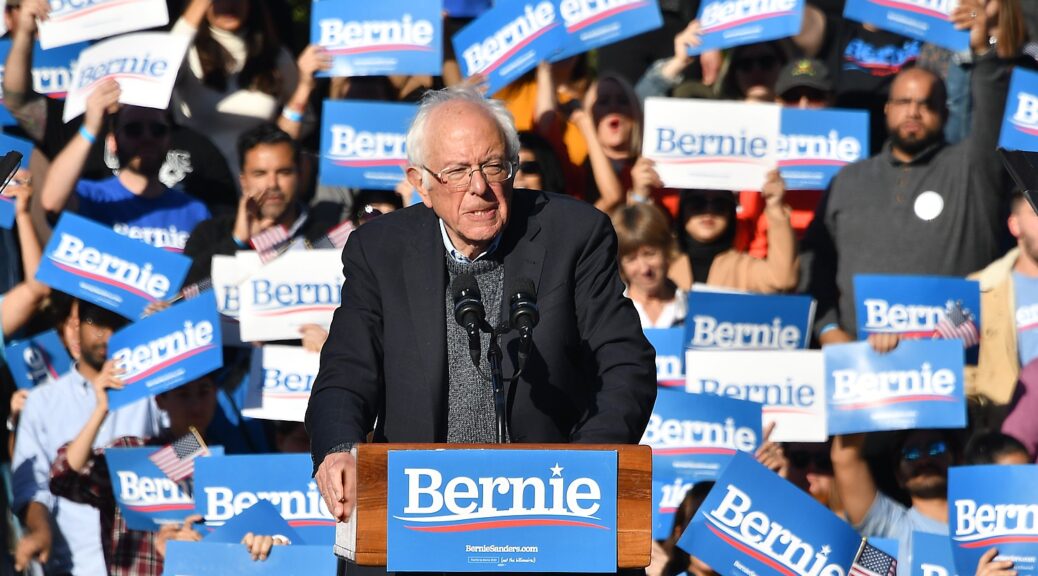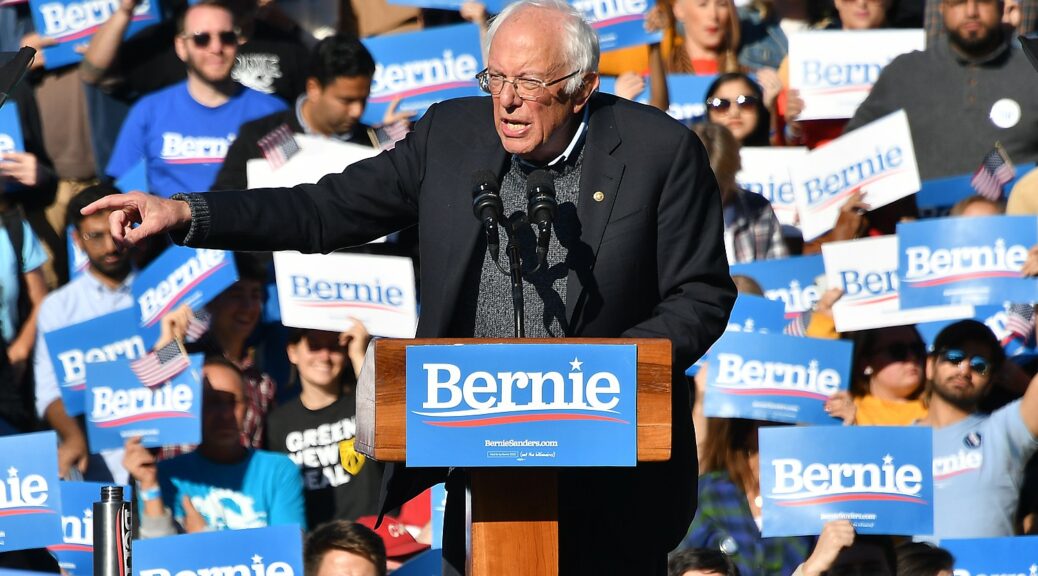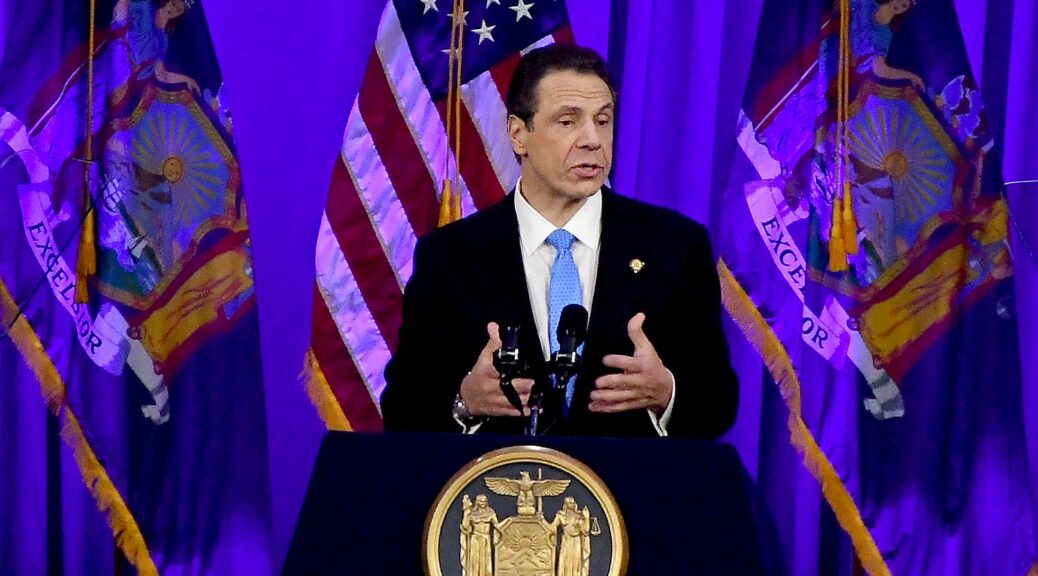
By Karen Rubin, News-Photos-Features.com
Governor Andrew M. Cuomo proposed a positive reform agenda to address systemic racism and police brutality amidst the ongoing protests across the state and nation in response to the killing of George Floyd. The reform agenda includes a national ban on excessive force and chokeholds by law enforcement officers; independent investigations of police brutality conducted by independent, outside agencies – not by local prosecutors; and disclosure of disciplinary records of police officers being investigated.
While standing firmly in support of the protests against police brutality, the Governor said that protest for its own sake would only work against the cause, but that there needs to be a clearly defined list of actions that need to be articulated.
“You want to make that moment work,” he declared. “Yes, you express the outrage. But then you say, ‘Here’s my agenda. Here’s what I want.’ That’s what we have to be doing in this moment. And the protesters are making a point. And most of them are making a smart, sensible point. But you have to add the positive reform agenda that every voice calls for so the government, the politicians know what to do. And there is a positive reform agenda here. There should be a national ban on excessive force by police officers. There should be a national ban on chokeholds. Period. There should be independent investigations of police abuse.”
And Cuomo also differentiated between the those who are exercising their Constitutional First Amendment right to protest against those who are taking advantage to loot and vandalize, giving Trump the opportunity to deflect and discount, and shift focus to himself as the “law-and-order” strongman. Indeed, there are reports that White Nationalist group is posing as Antifa on Twitter, calling for violence. Trump is proposing to designate Antifa a terrorist group, and is using them to justify calling out military against protesters – which would be a violation of the Posse Comitatus Act.
“There’s no doubt that what the President’s trying to do here is turn the attention to the looters rather than the point of the protest, which is genuine outrage,” Cuomo said in an interview with Nicolle Wallace on MSNBC. “”You look at what happened with Mr. Floyd, you have to be outraged. It’s not just Mr. Floyd in an isolated situation, it’s been years and years of the same situation. You can go back to Rodney King, Amadou Diallo and Eric Garner – it’s a long list.
“They want to make this about looting and criminals rather than the killing. That’s what they’re trying to do. In New York, we did have large protests and we do have people who are, I think, exploiting the protest. There’s no doubt that there’s some people who came out and did looting and criminal activity. You have some disrupting organizations that are seizing upon the moment. We want to make sure that order is maintained and we’re putting in place a curfew.”
“Use this moment. You look in history, Nicolle, when did change come? Change came when the people insisted on change. Let’s talk about investigation of police abuse. No chokeholds, nation-wide standard for undue force. Let’s talk about funding of education and equal funding in education. Let’s talk about affordable housing. Let’s talk about a child poverty agenda. Let’s use the moment constructively.”
Cuomo ordered a curfew of 11 pm in New York City, and doubled the number of police, from 4,000 to 8,000. However, that was not enough to stop a spate of acts of looting and vandalism.
The protests come just as New York City was hitting the milestones in the fight against COVID-19, which has taken more lives – and more disproportionately in communities of color – in the city and state than anywhere in the country or world. The Governor said that if there was any “silver” lining in the timing, the protests are happening when the infection rate has been cut from 20 percent to 2 percent but still raised concerns of reigniting the spread of the pandemic.
Here is a transcript of Governor Cuomo’s remarks:
We’re talking about reopening in one week in New York City. Now we’re seeing these mass gatherings over the past several nights that could, in fact, exacerbate the COVID-19 spread. We spent all this time closed down, locked down, masked, socially distanced and then you turn on the TV and you see there’s mass gatherings that could potentially be infecting hundreds and hundreds of people. After everything that we have done. We have to talk a minute and ask ourselves what are we doing here? What are we trying to accomplish?
We have protests across the state that continued last night, they continued across the nation. Upstate we worked with the cities very closely. The State Police did a great job. We had, basically, a few scattered arrests, upstate New York. But the local governments did a great job, the people did a great job, law enforcement did a great job. The protestors were responsible. It wasn’t great, but it wasn’t bad, either, upstate.
I said from day one, I share the outrage and I stand with the protestors. You look at that video of the killing of an unarmed man, Mr. Floyd, it is horrendous. Horrendous. It’s frightening. It perverts everything you believe about this country. It does and there’s no excuse for it. No right minded American would make an excuse for it. So, protest yes. Be frustrated, yes. Outraged, yes of course. Is there a larger problem? Of course. It’s not just Mr. Floyd, it goes back – there are 50 cases that are just like Mr. Floyd. We’ve them here in New York City. What’s the difference between Mr. Floyd and Amadou Diallo? Or Abner Louima? Or Eric Garner? What is the difference? What have we learned? Nothing?
So, yes, we should be outraged. And yes, there’s a bigger point to make. It is abuse by police. But it’s something worse. It is racism. It is discrimination. It is fundamental inequality and injustice. My father spoke about it in 1984. The speech called “The Tale of Two Cities.” People still talk about it. The point of the tale of two cities is there’s two Americas. Two sets of rules. Two sets of outcomes. Two sets of expectations. It’s true. It was true then, it’s true now. Look at our prisons and tell me there’s not inherit injustice in society. Look at public housing, tell me there’s not inherent injustice.
Look at what happened with this COVID infection rate nationwide. More African Americans infected, more African Americans dead proportionally than white Americans. Of course, there’s chronic institutionalized discrimination. There is no doubt. There is no doubt. And there’s no doubt that it’s been going on for a long time and people are frustrated, and it has to be corrected and it has to be corrected now. And there’s no doubt, that this nation as great as it is has had the continuing sin of discrimination. From before the nation was formed and it started with slavery. And it has had different faces over the decades, but it’s still the same sin. That is true. That is true. So let’s use this moment as a moment of change? Yes.
When does change come? When the stars align and society focuses and the people focus, and they focus to such an extent that the politicians follow the people. That’s when change comes. “Well, the leaders lead!” Baloney. The people lead. And then the politicians see the people moving, and the politicians run to catch up with the people. How did we pass marriage equality in this State, giving a new civil right to the LGBTQ community? Because the people said, “enough is enough. How can you say only heterosexual people can marry, but the LGBTQ people— they can’t marry? How is that constitutional? How is that legal?” You have your own preference— God bless you. But how in the law, do you discriminate between two classes of people. We passed marriage equality.
After the Sandy Hook massacre, after all those years we tried to pass common sense gun safety. Do you really need an assault weapon to kill a deer? But then the Sandy Hook massacre happened, and the people said, “enough. You’re killing children? Young children in schools with an assault weapon? In the Sandy Hook massacre. Enough.”
And in that moment, we passed common sense gun safety in the State of New York. Record income inequality? People said, “enough” and passed a real minimum wage in this State that went all across the nation. There’s a moment for change, and is there a moment here? Yes. If we’re constructive and if we’re smart, and if we know what were asking for! It’s not enough to come out and say, “I’m angry, I’m frustrated.” OK. And what? “Well, I don’t know, but I’m angry and frustrated.”
And you want what done? You need the answer. “Well, I want common sense gun reform.” OK, what does it look like? Here it is— three points. “Well I want to address income inequality.” Well, what do you want? “Here’s what I want. Minimum wage at $15. Free college tuition.” What do you want?
You want to make that moment work. Yes, you express the outrage! But then you say, “here’s my agenda. Here’s what I want.” That’s what we have to be doing in this moment. And the protestors are making a point. And most of them are making a smart, sensible point. But you have to add the positive reform agenda that every voice calls for so the government, the politicians know what to do. And there is a positive reform agenda here. There should be a national ban on excessive force by police officers. There should be a national ban on chokeholds. Period. There should be independent investigations of police abuse. When you have the local District Attorney doing the investigations— I don’t care how good they are— there is the suggestion of a conflict of interest. Why? Because that DA works with that police department every day and now that prosecutor is going to do the investigation of that police department that they work with every day? Conflict of interests can be real or perceived. How can people believe that the local prosecutor who works with that police department is going to be fair in the investigation? It shouldn’t be state by state. Minnesota Governor Walz put the attorney general in charge. Good. In this state, I put attorney general in charge of investigations where police kill an unarmed person. Good. But it shouldn’t be the exception. It should be the rule. There is no self-policing. There’s an allegation, independent investigation. Give people comfort that the investigation is real.
If a police officer is being investigated, how is there disciplinary records not relevant? Once a police officer is being investigated, if they have disciplinary records that show this was a repeat pattern, how is that not relevant? By the way, the disciplinary records can also be used to exonerate. If they have disciplinary records that say he never, she never did anything like this before, fine. That’s relevant too.
We still have two education systems in this country. Everybody knows it. Your education is decided by your zip code. Poorer schools in poorer communities have a different level of funding than richer schools in this state. $36,000 per year we spend in a rich district. $13,000 in a poor district. How do you justify that? If anything, the children in a poorer community need more services in a school, not less. How do you justify that? You can’t. Do something about it. You still have children living in poverty in this nation? Well, when we had to, we found a trillion dollars to handle the COVID virus, but you can’t find funding to help children who live in poverty? No, you can find it, United States. You just don’t want to. It’s political will. When you need to find the money, you can find it. Let’s be honest, the federal government has a printing press in their basement. When they have the political will, they find the money.
The federal government went out of the housing business and never re-entered it. We have a national affordable housing crisis. Of course you do. You don’t fund affordable housing. I’m the former HUD secretary. I know better than anyone what the federal government used to do in terms of affordable housing with Section 8 and building new public housing. And we just stopped, and we left it to the market. Now you have an affordable housing plan. That’s what we should be addressing in this moment. And we should be saying to our federal officials, “There’s an election this year, a few months away. Here’s my agenda. Where do you stand?” Say to the congress, the House and Senate, “Where’s your bill on this?”
I heard some congressional people talking saying well maybe they’ll do a resolution. Yeah, resolutions are nice. Resolutions say in theory I support this. Pass a law, that’s what we want. A law that actually changes the reality, where something actually happens. That’s government’s job is to actually make change. Make change. You’re in a position to make change. Make change. Use this moment to galvanize public support. Use that outrage to actually make the change. And have the intelligence to say what changes you actually want. Otherwise, it’s just screaming into the wind if you don’t know exactly what changes we need to make.
And we have to be smart in this moment. The violence in these protests obscures the righteousness of the message. The people who are exploiting the situation, the looting, that’s not protesting. That’s not righteous indignation. That’s criminality and it plays into the hands of the people and the forces that don’t want to make the changes in the first place because then they get to dismiss the entire effort. I will tell you what they’re going to say. They’re going to say the first thing the President said when this happened. They’re going to say “These are looters.” Remember when the President put out that incendiary tweet? “We start shooting when they start looting or they start looting, we start shooting?” That’s an old ’60s call. The violence, the looting, the criminality plays right into those people who don’t want progressive change. And you mark my words, they’re going to say today, “Oh you see, they’re criminals. They’re looters. Did you see what they did breaking the store windows and going in and stealing?” And they’re going to try to paint this whole protest movement that they’re all criminals, they’re all looters. That’s what they’re going to do. Why? They don’t want to talk about Mr. Floyd’s death. They don’t want people seeing that video. They want people seeing the video of the looting. And when people see the video of the looting they say “Oh yeah, that’s scary. They’re criminals.” No, look at the video of the police officer killing Mr. Floyd. That’s the video we want people watching.
Now, I don’t even believe it’s the protesters. I believe there are people who are using this moment and using the protest for their own purpose. There are people who want to sow the seeds of anarchy, who want to disrupt. By the way, there are people who want to steal. And here’s a moment that you can use this moment to steal. You can use this moment to spread chaos. I hear the same thing from all the local officials. They have people in their communities who are there to quote unquote protest. They’re not from their community. They don’t know where they’re from, extremist groups, some people are going to blame the left, some people will blame the right. It will become politicized. But there is no doubt there are outside groups that come in to disrupt. There is no doubt that there are people who just use this moment to steal. What, it’s a coincidence they broke into a Rolex watch company? That was a coincidence? High end stores, Chanel. That was a coincidence? That was random? That was not random. So, can you have a legitimate protest movement hijacked? Yes, you can. Yes, you can. And there are people and forces who will exploit that moment and I believe that’s happening.
But we still have to be smart. And at the same time, we have a fundamental issue which is we just spent 93 days limiting behavior, closing down, no school, no business, thousands of small businesses destroyed. People will have lost their jobs. People wiped out their savings. And now mass gatherings with thousands of people in close proximity one week before we’re going to reopen New York City? What sense does this make? Control the spread, control the spread, control the spread. We don’t even know the consequence for the COVID virus of those mass gatherings. We don’t even know. We won’t know possibly for weeks. It’s the nature of the virus. How many super-spreaders were in that crowd? “Well, they were mostly young people.” How many young people went home and kissed their mother hello or shook hands with their father or hugged their father or their grandfather or their brother or their mother or their sister and spread a virus?
New York City opens next week. Took us 93 days to get here. Is this smart? New York tough. We went from the worst situation to reopening. From the worst situation to 54 deaths in 50 days. We went from the worst situation to reopening in 93 days. We did that because we were New York tough. New York tough was smart. We were smart. We were smart for 93 days. We were united, we were respectful of each other. We were disciplined. Wearing the mask is just discipline, it’s just discipline. Remember to put it on, remember to pick it up, remembering to put it on when see someone, it’s just discipline.
It was also about love. We did it because we love one another. That’s what a community is. We love one another. And yes, you can be loving even in New York. Even with the New York toughness, even with a New York accent, even with a New York swagger. We’re loving. That’s what we’ve done for 93 days in a way we’ve never done it before. Never in my lifetime. Never in my lifetime has this city and this state come together in the way we have. I don’t think it ever will again, in my lifetime. Now you can say maybe it takes a global pandemic for it to happen. I don’t know if that’s true and I don’t know that the power of what it was like when it came together might not be so beautiful that people want to do it again.
Remember when we all acted together during coronavirus and we rallied and we knocked coronavirus on its rear end. Remember when we all wore masks and we had to have hand sanitizer? Remember what we did? Wow. When we come together, we can do anything and it’s true. It’s true for the state, it’s true for a nation. When you come together and you have one agenda you can do anything. You want to change society, you want to end the tale of two cities, you want to make it one America? You can do that, just the way you knocked coronavirus on its rear end.
People united can do anything. We showed that, we just showed that the past 93 days. We can end the injustice and the discrimination and the intolerance and the police abuse. We have to be smart. We have to be smart right now. Right now in this state. We have to be smart tonight in this city because this is not advancing a reform agenda. This is not persuading government officials to change. This is not helping end coronavirus. We have to be smart.
________________________
© 2020 News & Photo Features Syndicate, a division of Workstyles, Inc. All rights reserved. For editorial feature and photo information, go to www.news-photos-features.com, email [email protected]. Blogging at www.dailykos.com/blogs/NewsPhotosFeatures. ‘Like’ us on facebook.com/NewsPhotoFeatures, Tweet @KarenBRubin







